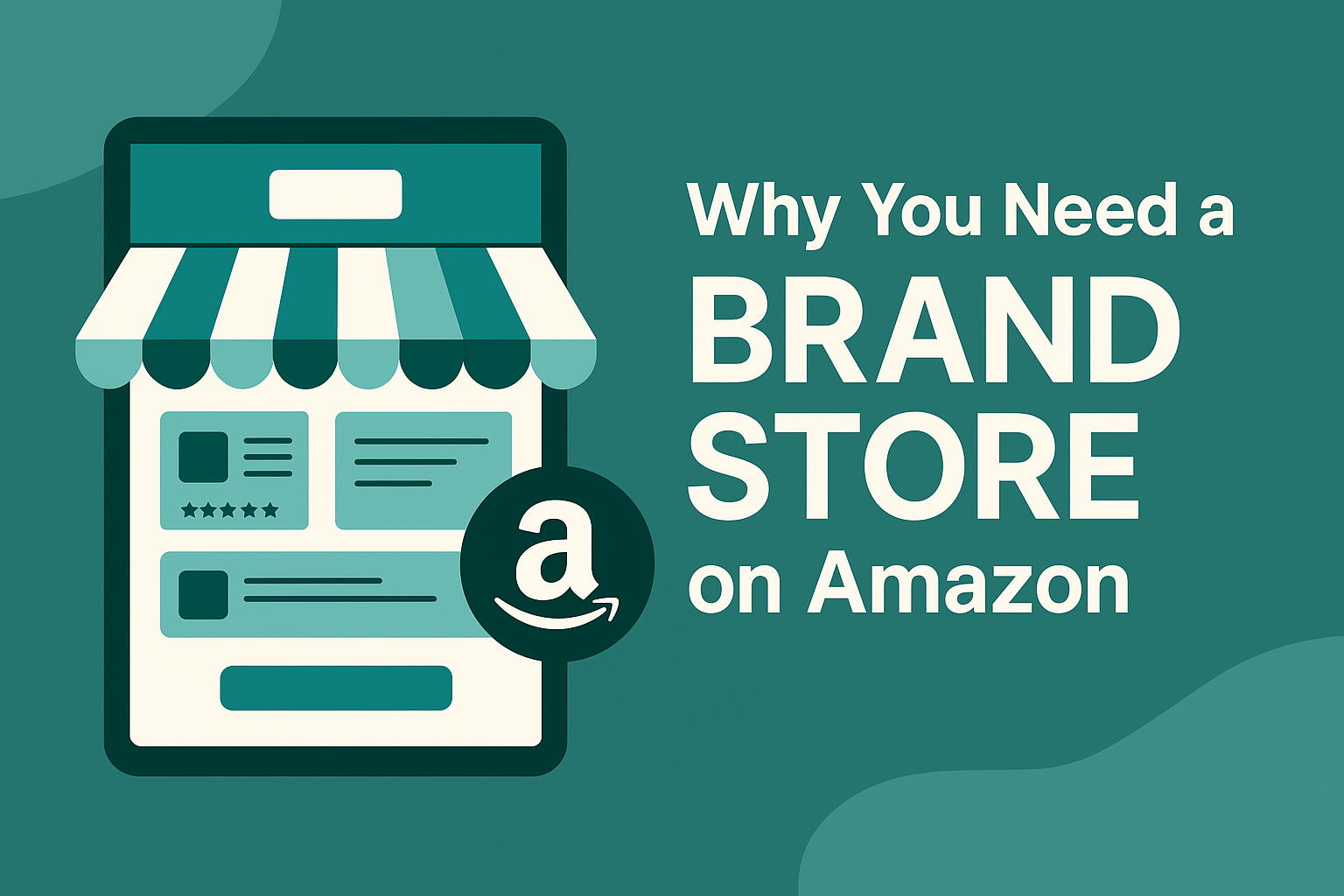Introduction: The Amazon Storefront Opportunity in 2025
In 2025, building a successful brand on Amazon requires more than great products and compelling listings. With competition at an all-time high, new and growing sellers need a way to stand out, tell their story, and convert browsers into buyers.
That’s where the Amazon Storefront comes in.
An Amazon storefront (officially called an Amazon Brand Store) is a powerful, customizable space that allows brand-registered sellers to showcase their products, communicate their unique value, and deliver an immersive shopping experience—all within the Amazon ecosystem.
Unlike standard product detail pages, a storefront puts your entire brand on display, giving you control over how customers perceive and engage with your offerings. If you’re not leveraging this free and conversion-optimized feature, you’re missing a key opportunity to elevate your presence and performance on Amazon.
This guide will walk you through the importance of creating an Amazon storefront, how to analyze competitors who are using Brand Stores effectively, and how to build a storefront that actually drives growth.
Step 1: Understand What an Amazon Storefront Is
Before diving into competitor research or strategy, it’s important to clearly define what a storefront is—and what it’s not.
An Amazon storefront is a customizable, multi-page shopping destination within Amazon. It’s exclusive to sellers enrolled in Amazon Brand Registry, meaning you need a registered trademark to access it. Unlike basic seller profile pages (sometimes called “storefronts” informally), this branded space allows you to:
- Showcase your full product catalog in one place.
- Create rich visual layouts with banners, videos, and product grids.
- Tell your brand story and highlight key product features.
- Drive traffic from Amazon Ads, social media, or email marketing to a branded, conversion-optimized destination.
Amazon provides templates, drag-and-drop functionality, and Store Insights, a built-in analytics dashboard to monitor page performance, traffic sources, and conversions.
Step 2: Why Amazon Storefronts Matter for Brand Growth
For growing brands, a storefront isn’t just a nice-to-have—it’s a strategic tool that influences everything from customer experience to advertising efficiency.
Build Brand Trust and Identity
Customers trust brands that look polished and consistent. An Amazon storefront gives you control over layout, imagery, copy, and messaging, allowing you to reflect your real-world brand identity inside Amazon.
Increase Product Discoverability
Without a storefront, your products are scattered across individual pages. With a storefront, customers can browse your entire catalog, increasing the likelihood of cross-selling and upselling.
Improve Ad Performance
Sponsored Brands campaigns perform better when they direct traffic to a storefront rather than a single product detail page. In fact, according to Amazon, stores that are updated every 90 days see 13% higher attributed sales per visitor and 11% more repeat visits.
Protect Against Competitor Distractions
When a customer lands on a detail page, they see competing product ads. But when they visit your storefront, they only see your brand. It’s a distraction-free zone for engagement and conversion.
Step 3: Analyze Competitor Storefronts for Insights
Creating an Amazon storefront that converts starts with competitive research. Here’s how to conduct a detailed analysis of your category.
Identify Direct Competitors with Stores
Search your primary keywords on Amazon and open listings of top-ranking brands. Click on the brand name above the product title—this will take you to their storefront if one exists.
Document:
- Which brands have storefronts?
- What do their homepage and category pages look like?
- How often are they updated?
- Do they use rich media (e.g., video, infographics)?
- What’s the tone and style of their messaging?
Evaluate Structure and Navigation
Strong storefronts have intuitive navigation. Note whether your competitors:
- Have subpages for product categories
- Highlight best sellers or bundles
- Promote seasonal campaigns
- Include comparison charts or educational content
Analyze Brand Positioning
Is their store focused on price, lifestyle, performance, or innovation? Do they use consistent branding (colors, fonts, logos) across pages?
This step helps you decide whether to differentiate or compete directly with similar positioning.
Measure Engagement Signals
While you can’t access a competitor’s analytics, you can infer engagement by:
- The quality and frequency of content updates
- Use of advanced content formats like video and dynamic modules
- Placement in Sponsored Brand Ads leading to their Store
Use this intelligence to set benchmarks for your own store design and content cadence.
Step 4: Start Creating Your Amazon Storefront
Once you’ve analyzed your competition and decided on your brand’s positioning, it’s time to build.
Step-by-Step Process
- Enroll in Brand Registry
You’ll need a registered trademark to qualify. If you haven’t done this yet, it’s a critical step to unlock storefront capabilities. - Go to Stores → Manage Stores in Seller Central
Access the Amazon Store builder through your advertising console. - Choose Your Template
Amazon offers several layout options:
- Marquee (great for lifestyle brands)
- Product Highlight (ideal for showcasing multiple items)
- Grid or Showcase (clean, retail-style presentation)
- Marquee (great for lifestyle brands)
- Upload Your Brand Assets
- Logo (minimum 400×400 px)
- Hero banners
- Product lifestyle images
- Video (if available)
- Logo (minimum 400×400 px)
- Create Subpages for Navigation
Divide your store into logical categories: collections, use cases, new arrivals, best sellers, or solutions. - Write SEO-Friendly Copy
Include keyword-rich headlines and product descriptions. Write clearly and focus on customer benefits. - Preview and Submit for Review
Amazon typically takes 24–72 hours to approve a new store or updates.
Need help with visuals or layout planning? Explore our Portfolio to see real examples of storefronts, infographics, and A+ visuals we’ve created for brands like yours.
Step 5: Optimize for Conversion and Visibility
Once your storefront is live, optimization becomes an ongoing priority.
Keep Content Fresh
Update hero banners seasonally. Feature new product launches or highlight current deals. Frequent updates not only improve engagement but also encourage Amazon to reward your Store with higher visibility.
Use Store Insights
Monitor:
- Page views
- Click-through rates
- Top-performing subpages
- Traffic sources (ads vs. organic)
This data helps you understand which sections are performing—and which need improvement.
Link Your Store in Ads and External Campaigns
Drive traffic to your Amazon storefront from:
- Sponsored Brands Ads
- Your email marketing
- Instagram bios and social media posts
- Your website’s “Shop Now” button
This increases conversion consistency across channels and keeps customers in your branded ecosystem.
Step 6: Avoid Common Storefront Mistakes
Many sellers rush through storefront creation without considering design, structure, or messaging. Avoid these pitfalls:
- Overloading the homepage with too many products or modules
- Neglecting mobile design (where over 60% of traffic comes from)
- Using inconsistent branding across pages
- Failing to update seasonal content or highlight promotions
- Not leveraging analytics to refine structure and messaging
Your storefront is a dynamic marketing asset—not a one-and-done task.
Conclusion: Take Control of Your Amazon Brand Identity
In today’s Amazon marketplace, starting an Amazon storefront is no longer optional—it’s essential. A well-crafted brand store helps you:
- Centralize your product catalog
- Elevate your brand image
- Improve ad ROI
- Foster loyalty and trust
- Protect against competitor disruption
By conducting smart competitor analysis, building strategically, and optimizing with data, you’ll position your brand for long-term growth on Amazon.
Ready to build a store that converts? Book a Call with our team at Bits & Atoms, and let’s create a storefront that performs as beautifully as it looks.


